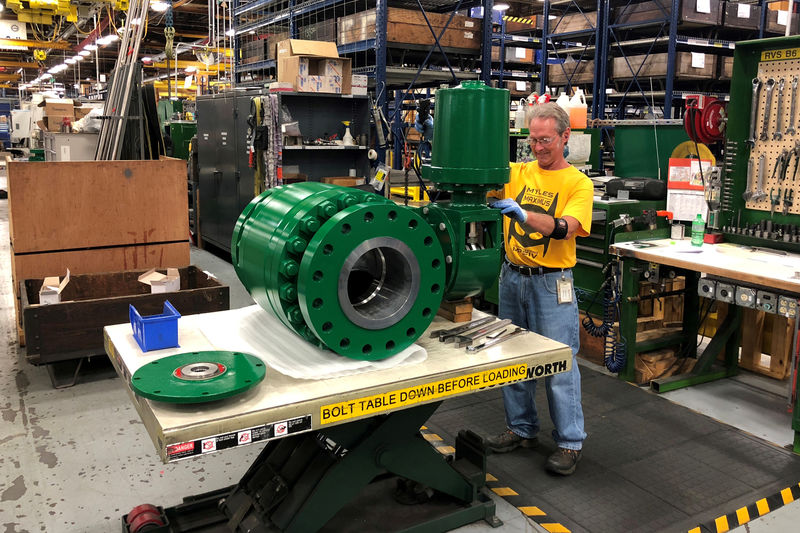By Lucia Mutikani
WASHINGTON (Reuters) - U.S. manufacturing activity slowed to a 2-1/2-year low in April amid a sharp drop in new orders while construction spending unexpectedly fell in March, suggesting economic growth was moderating after surging in the first quarter.
One of the reports from the Institute for Supply Management (ISM) on Wednesday showed businesses increasingly anxious that President Donald Trump's threats to close the U.S.-Mexico boarder would further disrupt the supply chain. Washington's trade war with China has created bottlenecks at factories.
The Federal Reserve kept U.S. interest rates unchanged on Wednesday, noting solid economic growth in the first quarter, and also holding out hope that inflation will rise toward the U.S. central bank's 2 percent target.
"The slowing manufacturing sector needs to be watched carefully as income gains are not strong enough to support solid growth," said Joel Naroff, chief economist at Naroff Economic Advisors in Holland, Pennsylvania.
The ISM said its index of national factory activity fell to 52.8 in April, the lowest reading since October 2016, from 55.3 in March. A reading above 50 indicates expansion in the manufacturing sector, which accounts for about 12 percent of the U.S. economy.
Economists polled by Reuters had forecast the ISM index dipping to 55.0 in April. The slowdown in manufacturing partly reflects sluggish global economies and continued uncertainty over the trade talks between the United States and China. A stockpile of unsold goods is also seen slowing manufacturing.
The ISM said 13 industries, including machinery, computer and electronic products, furniture, and electrical equipment, appliances and components reported growth last month. Apparel, transportation equipment and three other industries reported a contraction.
Manufacturers in the electrical equipment, appliances and components industry said "there is growing concern about supply chain product flow through the southern U.S. border." Those worries were also echoed by their counterparts in the computer and electronic products industry who said "Mexico-U.S. border crossing delays are slowing supplier deliveries."
Machinery and transportation equipment manufacturers said they were also monitoring the situation on the U.S. southern boarder. Trump has repeatedly threatened to shut down the border because of a surge in illegal immigrants seeking to enter the United States.
The dollar fell against a basket of currencies, while U.S. Treasury prices rose. Stocks on Wall Street were trading higher.
WEAK FACTORY ORDERS
The ISM's new orders sub-index dropped 5.7 points to a reading of 51.7 last month. More industries reported paying less for raw materials, which suggest inflation will probably remain muted for a while. A measure of export orders also fell and factories reported a decline in hiring, with a measure of manufacturing employment falling to 52.4 from 57.5 in March.
That suggests manufacturing payrolls remained weak in April after they dropped in March for the first time since July 2017. Weak manufacturing employment in April also suggested a step-down in overall job growth last month. The government is scheduled to publish April's employment report on Friday.
"The U.S. manufacturing sector remains under pressure," said Sarah House, a senior economist at Wells Fargo (NYSE:WFC) Securities in Charlotte, North Carolina. "We expect the sector's contribution to payrolls to be noticeably more minimal in the months ahead."
While the ADP (NASDAQ:ADP) National Employment Report on Wednesday showed private payrolls increased by 275,000 jobs in April, Moody's Analytics, who jointly developed the report downplayed the surge in hiring saying it "overstate the economy's strength."
It was the biggest private payrolls increase in nine months and followed a 151,000 gain in March. The economy grew at a 3.2 percent annualized rate in the first quarter, the government reported in its advance estimate last week, after expanding at a 2.2 percent pace in the October-December period.
The ADP report has a poor record of predicting the private payrolls component of the government's employment report.
Economists polled by Reuters are looking for nonfarm employment to have increased by 185,000 jobs after rising by 196,000 in March. Job growth has slowed from last year's 223,000 monthly average pace as workers become scarce.
The pace of job gains, however, remains above the roughly 100,000 per month needed to keep up with growth in the working age population. The unemployment rate is forecast to be unchanged at 3.8 percent in April.
A third report from the Commerce Department on Wednesday showed construction spending decreased 0.9 percent in March.
Data for January and February was revised lower to account for additional projects identified as eligible for inclusion in the series. Economists polled by Reuters had forecast construction spending rising 0.1 percent in March.
